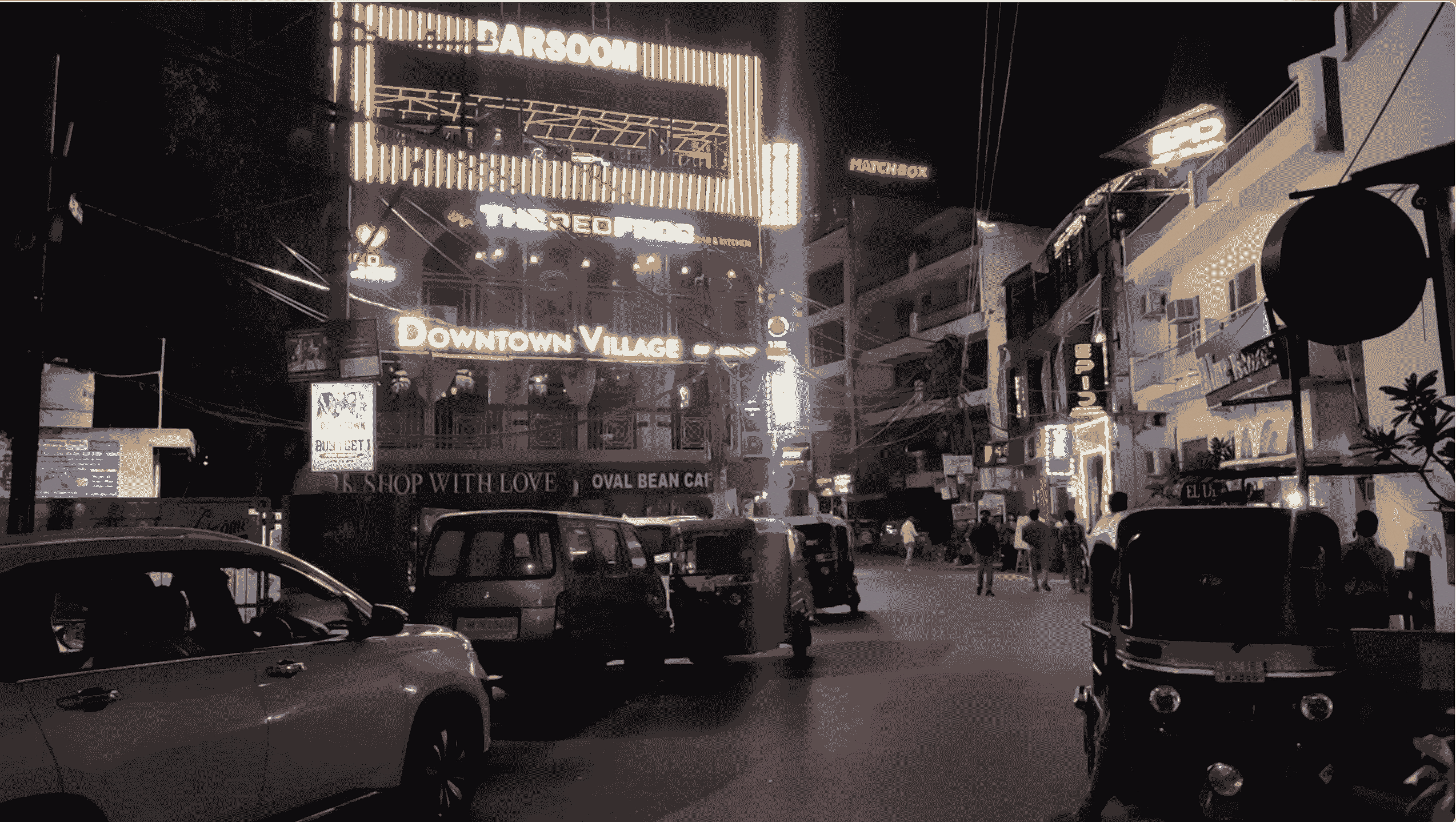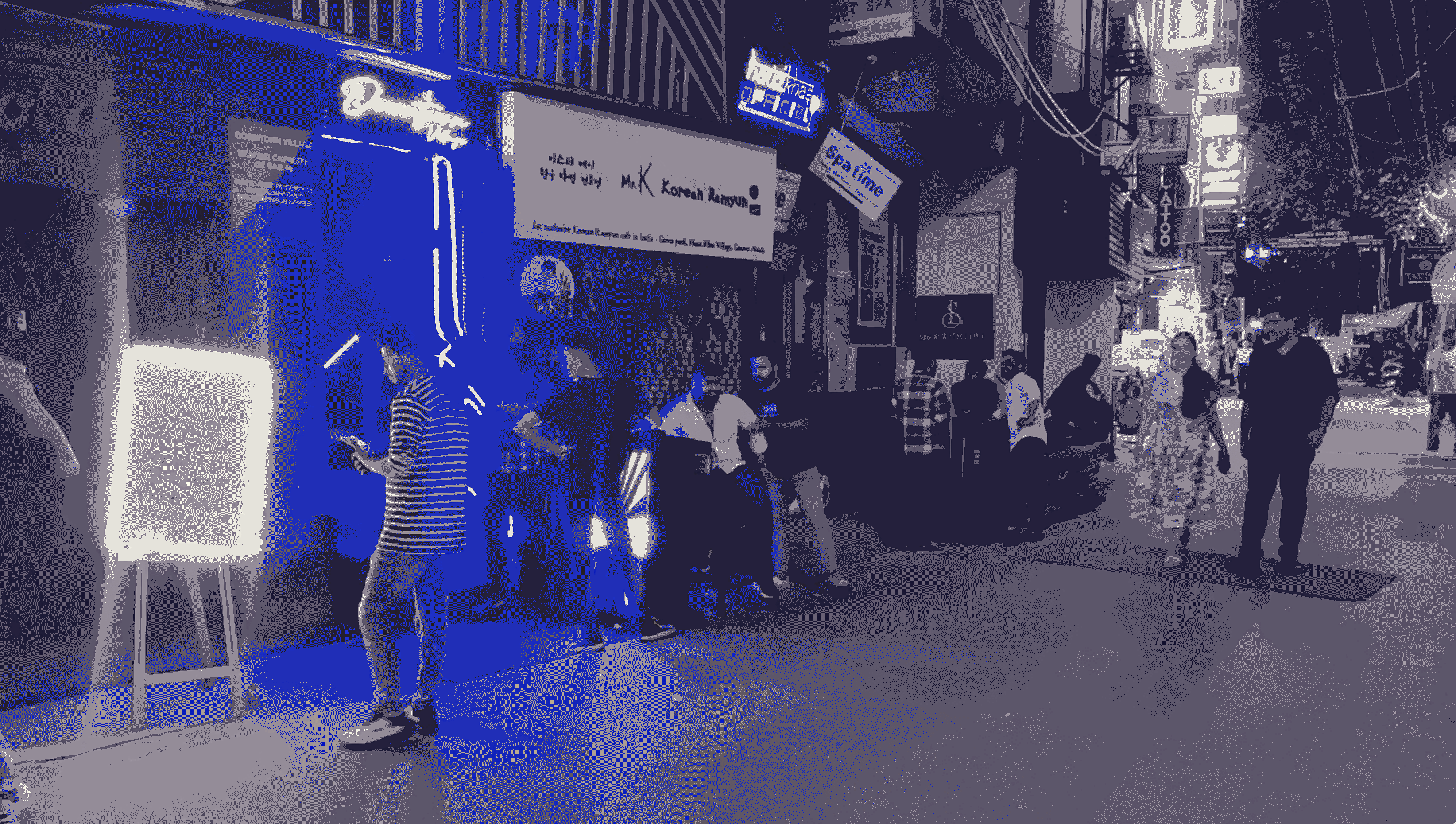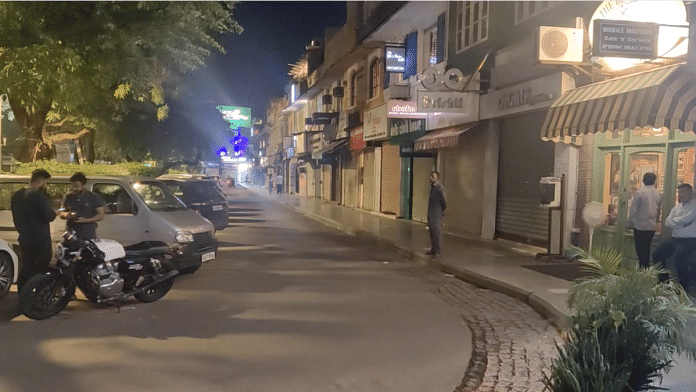New Delhi: It is just past 10 pm on a Wednesday, and the crowd at Delhi’s famed Connaught Place market has already started to thin. Except for pubs, restaurants and the odd paan shop, most commercial establishments have shut down for the day. The few that are still open are only waiting to let out the stragglers.
By midnight, the market that’s bustling in the day becomes what a passerby describes as a “dead scene” — its wide roads are almost empty, barring a few lingering groups of people.
Other commercial hubs in Delhi, too, witness such scenes — by 11 pm, most of the shops are shut in Khan Market and its parking lot is almost vacant, while the roads around Hauz Khas Village are lined with patrons about to head home.
Earlier this week, Delhi Chief Minister Arvind Kejriwal gave the approval for 155 establishments to stay open round-the-clock — the latest of successive governments’ attempts to promote the city’s night economy. This is in addition to the 314 establishments that got the nod in October 2022.
Both Kejriwal and Lieutenant Governor V. K. Saxena are keen to foster a robust night economy in Delhi. In February this year, the L-G announced a modified unified portal to ease licensing processes for the city’s hospitality industry. The decision came two months after he set up a panel to review licensing requirements in order to help boost the city’s night- and open-air dining, according to reports.
And yet, such efforts appear to be a non-starter. Most visitors that ThePrint spoke to in all three hubs — Connaught Place, Khan Market and Hauz Khas Village — gave mixed views on whether the city has a nightlife at all.
Put simply, a night economy isn’t a term merely used to connote partying late. It’s a broader concept that involves extending the timings of work spaces and commercial facilities in order to promote the local economy. A nightlife, on the other hand, is a by-product of a night economy.
In its yet-to-be-approved Master Plan for Delhi 2041 (MPD-2041), the Delhi Development Authority (DDA), a body for housing projects which comes under the Ministry of Housing and Urban Development, enumerated the contours of what it views as a night economy. This includes identifying areas where it could extend the working hours of business establishments.
But Delhi residents believe the biggest hurdles coming in the way of this are the city’s safety and security issues.
When ThePrint caught up with him outside a paan shop at Connaught Place, Srikanth (who only gave his first name) denied Delhi has any semblance of a nightlife. Having moved to the national capital from Gujarat in 2008, Srikanth said one of the major reasons for this could be that the city is perceived as unsafe.
“Gujarat is not known for its nightlife, but it changes during the garba festival. At that time there’s a night life, and it’s safe, particularly for women. Delhi’s case is the stark opposite,” he said.
But law and order isn’t the only challenge to Delhi’s night economy — policy problems when it comes to its licensing system is the other, according to city traders. Multiple government agencies with separate jurisdictions hold key to giving the mandatory licences required to run these establishments, leading to bureaucratic hassles.
Vijay Kumar Singh, DDA member (finance), said there were several factors involved in promoting the night economy. “Promoting the hospitality sector alone will never result in achieving the intended goal of having a vibrant nightlife,” he told ThePrint.
Delhi Police spokesperson Suman Nalwa denied any shortcomings in the city’s policing system. “If there is a policy that allows establishments to be open till extended hours, then they (police) will act in accordance with the policy.”
Also Read: ‘If I am not safe…,’ Delhi women’s body chief ‘molested’, dragged by drunken driver
‘Security issues, unclear policy’

Nishant Gupta, 32, believes that although Delhi’s not completely devoid of a nightlife, it isn’t the same as cities like Mumbai and Pune, where “one can enjoy until the morning”.
It’s not just a sprawling mega city like Mumbai that boosts of a night economy — for instance, Ahmedabad’s Law Garden, a major market for fabric, clothing and jewellery, is bustling with activity until at least till 11 pm while Indore’s famous street food market, Sarafa Bazaar, stays open till 1 am.
A Delhi government official told ThePrint that some efforts have been made in the past to push the city’s night economy — in the early 2000s, for instance, the then Congress government under Sheila Dikshit announced a bazaar to promote night shopping — but such plans never materialised.
According to K.T. Ravindran, an urban designer and the former dean of Amity University’s RICS School of Built Environment, there were several reasons for Delhi’s nightlife failing to pick up — the most important of which is the city’s structure. Delhi, he said, is radial like Bengaluru.
“But Bengaluru has a central area that is concentrated with places of entertainment. In Delhi, the structure of the city and the method of policing have resulted in spreading the places of entertainment in different locations. This isn’t conducive to having a nightlife,” Ravindran told ThePrint.
Security is also on 32-year-old doctor Prachi Singh’s mind when she steps out at night.
“From my perspective, it’s just the safety aspect,” Prachi told ThePrint at Khan Market. “The problem is that there is a section of people who don’t create a friendly vibe (sic). If these can be kept in check, maybe we can have a nightlife.”
Restaurant and market associations have welcomed the Delhi government’s decisions — not only the latest one but also L-G Saxena’s February announcement.
But according to traders, these changes don’t seem to reflect on the ground, primarily because of a lack of clarity on the policy.
Another challenge is how these decisions would translate into practical implementation. Atul Bhargava, president of the New Delhi Traders Association, cited the example of traffic restrictions around Connaught Place, one of Delhi’s most crucial commercial hubs, on New Year’s eve — one of the busiest nights of the year.
For instance, the Delhi Police announced in December last year that traffic would be restricted around the area in view of New Year celebrations to prevent “overcrowding”. Bhargava claimed the decision resulted in major losses for businesses.

“Now, you can imagine. If there’s nightlife and if there are many people and the police cannot control them, they will stop them from entering. How will the police manage if the city goes 24×7 (when they can’t do it on that one day)?” Bhargava asked while speaking to ThePrint. Trader bodies, he added, must be involved in the consultation process for such decisions to be effectively implemented.
The city’s lengthy licensing process is the other major challenge. In order to run a commercial establishment in Delhi, one requires permission, or licences, from multiple government agencies having separate jurisdictions, according Mahaveer Mohanty, a business owner who owns a pub at Hauz Khas and has two restaurants in Goa.
“One needs 20-odd licences, which is a problem. The unified (licence) portal is alright for now, considering that it’s only the first phase. The announcements are yet to show results on ground, we are 5 per cent there and 95 per cent not there yet,” Mohanty told ThePrint.
Delhi’s ‘lost’ nightlife
But Delhi hasn’t always been quite so bereft of a nightlife, according to Dilip Cherian, an image consultant and the founder of Perfect Relations, a Delhi-based public relations company.
He talked to ThePrint about a time in the late 80s and early 90s when Delhi’s nightlife was thriving — owing not only to the city’s “five-star coffee-shop-going” elite but also section of population that looked for a “cheap and cheerful nightlife” that often took them to South Delhi’s Moolchand, where several dhabas were “notoriously open through the night”.
Then came the 90s, when “nightlife aficionados” flocked to nightclubs, or discotheques as they were then called — including the iconic Ghungroo at ITC Maurya, which shut down in the early 2000s.
“There was a huge appeal to these clubs, but there also were too often instances of fist fights and rowdy behaviour,” said Cherian.
Eventually, the city administration tightened their security noose, slowly killing everything that made up Delhi’s nightlife.
But can this trend be revived again? Cherian remains doubtful. According to him, there are three essential components of a nightlife — good watering holes, security that does not hamper such activities, and spaces that one can drive to. Delhi is missing the last two components, he said, adding: “In Delhi, the best you can do is drive past Qutub Minar”.
DDA Master Plan and its idea of a ’24×7 city’
Key to Delhi government’s plan to revive the city’s lost nightlife is its Master for Plan for Delhi-2041. The DDA submitted it to the Ministry of Housing and Urban Development earlier this year but is still pending approval.
The first step, according to the proposal, is to identify night-time circuits that will attract tourists and locals and then extend timings for commercial establishments such as hotels, restaurants, socio-cultural spots, retail stores and sports facilities in order to help generate footfall.
Simultaneously, the plan also encourages the agencies to collaborate with artistes, cultural groups and market associations to organise seasonal festivals, theme-based night walks and night markets in these circuits.
However, DDA member Vijay Kumar Singh, quoted earlier, said that the plan will be limited to some areas instead of the whole city.
“If you talk to people, they will tell you that the infrastructure is not there, security is a major concern and there is a lack of mobility,” he said. “The Master Plan is a document that defines land uses and development norms, but it is also a statement of intent for what the city would become.”
(Edited by Uttara Ramaswamy)
Also Read: Preventive detention for bootleggers, cybercrooks — L-G clears bid to bring ‘draconian law’ to Delhi



